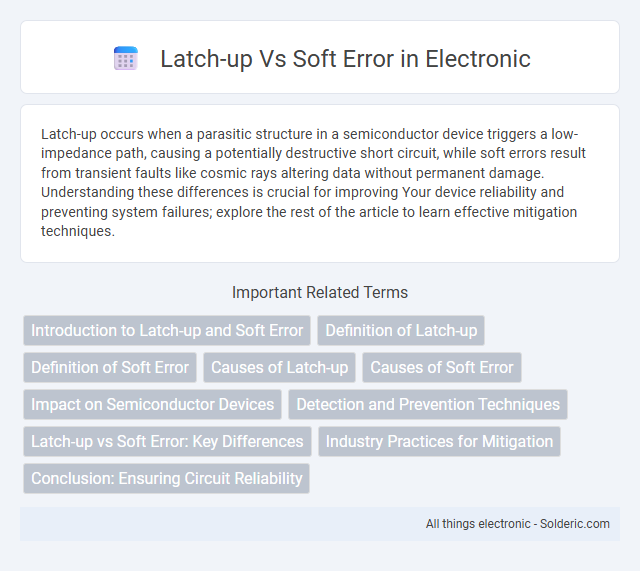Latch-up occurs when a parasitic structure in a semiconductor device triggers a low-impedance path, causing a potentially destructive short circuit, while soft errors result from transient faults like cosmic rays altering data without permanent damage. Understanding these differences is crucial for improving Your device reliability and preventing system failures; explore the rest of the article to learn effective mitigation techniques.
Comparison Table
| Feature | Latch-up | Soft Error |
|---|---|---|
| Definition | A parasitic structure triggering high current, causing device malfunction | Temporary fault caused by radiation-induced charge altering logic states |
| Cause | Triggering of parasitic thyristor in CMOS circuits | Cosmic rays, alpha particles, or neutrons impacting semiconductor |
| Effect | High current draw, possible device damage or latch-up condition | Single event upset (SEU) or bit flips in memory and logic circuits |
| Persistence | Persistent until power cycle or power removal | Transient, corrected by rewriting or error correction codes |
| Prevention | Layout techniques, guard rings, well contacts | Error Detection and Correction (EDAC), radiation-hardened design |
| Impact on Device | Potential permanent damage or functional interruption | No permanent damage, affects data integrity temporarily |
Introduction to Latch-up and Soft Error
Latch-up is a destructive short-circuit condition in CMOS circuits caused by parasitic thyristor structures, leading to high current and potential device failure. Soft errors occur when ionizing radiation or energetic particles cause transient faults or bit flips in semiconductor memory or logic without permanent damage. Both phenomena pose reliability challenges in integrated circuits but differ fundamentally in cause and effect.
Definition of Latch-up
Latch-up is a failure mode in CMOS devices where parasitic thyristor structures create a low-impedance path between power and ground, causing high current flow and potential device destruction. This phenomenon occurs due to triggering events like voltage spikes or ionizing radiation, leading to a self-sustaining latch state. Unlike soft errors, latch-up results in permanent damage unless power is cycled, distinguishing it as a critical reliability concern in integrated circuits.
Definition of Soft Error
Soft error refers to a transient fault in semiconductor devices caused by external radiation or cosmic rays, resulting in incorrect data without physical damage to the hardware. Unlike latch-up, which is a permanent short-circuit condition triggered by parasitic structures in CMOS technology, soft errors only temporarily disrupt the operation of a circuit. Understanding soft error is crucial for improving the reliability and error-correcting mechanisms in your electronic systems.
Causes of Latch-up
Latch-up is primarily caused by the unintended activation of parasitic thyristor structures within CMOS devices, often triggered by high current or voltage spikes, ionizing radiation, or transient voltage disturbances. Unlike soft errors, which result from transient bit flips due to radiation or electrical noise, latch-up creates a low-impedance path that can lead to device burnout if not mitigated quickly. Your circuit's design and layout, especially well spacing and guard rings, play critical roles in preventing latch-up events.
Causes of Soft Error
Soft errors are primarily caused by high-energy particles such as neutrons and alpha particles striking semiconductor materials, leading to transient faults in memory cells or logic circuits. Cosmic rays and radioactive decay within packaging materials induce charge disturbances that can flip bits without causing permanent damage. Your system's reliability depends on mitigating these soft errors through error correction codes and radiation-hardened design techniques.
Impact on Semiconductor Devices
Latch-up causes a significant surge in current that can permanently damage semiconductor devices by creating a low-impedance path between power and ground, leading to device malfunction or failure. Soft errors, caused by transient radiation-induced charge disturbances, typically result in temporary data corruption or logic glitches without causing lasting physical damage. Understanding the impact of both phenomena is crucial for designing robust semiconductor devices resistant to both permanent latch-up damage and transient soft error disruptions.
Detection and Prevention Techniques
Latch-up detection relies on monitoring abnormal current spikes using on-chip current sensors and built-in self-test (BIST) circuits, while soft error detection commonly employs error-correcting codes (ECC) and redundancy checks in memory arrays. Prevention techniques for latch-up involve guard rings, substrate contacts, and careful layout to isolate parasitic thyristors, whereas soft error prevention includes radiation-hardened designs, temporal/spatial redundancy, and hardened latches to mitigate single-event upsets (SEUs). Combining these approaches ensures robust operation in harsh environments by addressing both transient faults from radiation and permanent failure modes induced by latch-up.
Latch-up vs Soft Error: Key Differences
Latch-up occurs when a parasitic structure creates a low-impedance path, causing high current flow and potential device failure, while soft errors are transient faults caused by cosmic rays or radiation flipping bits in memory cells without lasting damage. Latch-up typically results in permanent hardware damage or requires device power cycling, whereas soft errors are temporary and usually corrected by error correction codes (ECC). Understanding these key differences helps you design more robust integrated circuits by addressing both physical latch-up protection and error mitigation strategies.
Industry Practices for Mitigation
Industry practices for mitigating latch-up include the use of guard rings, epitaxial substrates, and layout optimization to prevent unintended current paths in CMOS circuits. Soft error mitigation relies on error detection and correction codes (ECC), hardened cells, and redundancy techniques such as Triple Modular Redundancy (TMR) to improve resilience against transient radiation-induced faults. Both methods emphasize process technology improvements and rigorous testing to ensure device reliability in harsh environments.
Conclusion: Ensuring Circuit Reliability
Latch-up and soft errors pose significant risks to circuit reliability, with latch-up causing permanent device damage through parasitic structures and soft errors inducing transient faults from radiation or environmental noise. Mitigating latch-up requires robust layout design and protective circuitry, while soft error resilience depends on error-correcting codes and redundant architecture. Your circuit's long-term reliability hinges on addressing both phenomena through comprehensive design strategies and rigorous testing.
Latch-up vs Soft Error Infographic

 solderic.com
solderic.com